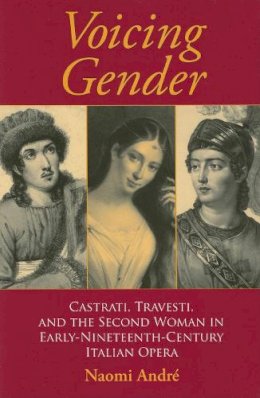6%OFF

Stock image for illustration purposes only - book cover, edition or condition may vary.
Voicing Gender: Castrati, Travesti, and the Second Woman in Early-Nineteenth-Century Italian Opera
Naomi André
€ 26.99
€ 25.32
FREE Delivery in Ireland
Description for Voicing Gender: Castrati, Travesti, and the Second Woman in Early-Nineteenth-Century Italian Opera
Paperback. The early 19th century was a period of acute transition in operatic tradition and style, when time-honoured practices gave way to the developing aesthetics of Romanticism, and the heroic, the masculine, and the feminine were profoundly reconfigured. This book traces the development of female characters in these first decades of the century. Series: Musical Meaning & Interpretation. Num Pages: 248 pages, 18 b&w photos, 1 bibliog., 1 index. BIC Classification: AVA; JFSJ1. Category: (P) Professional & Vocational. Dimension: 234 x 156 x 16. Weight in Grams: 404.
The early 19th century was a period of acute transition in operatic tradition and style, when time-honored practices gave way to the developing aesthetics of Romanticism, the rise of the tenor overtook the falling stars of the castrati, and the heroic, the masculine, and the feminine were profoundly reconfigured. These transformations resounded in operatic plot structures as well; the happy resolution of the 18th century twisted into a tragic 19th-century finale with the death of the helpless and innocent heroine—and frequently her tenor hero along with her. Female voices which formerly had sung en travesti, or basically in male drag, ... Read more
Show LessProduct Details
Format
Paperback
Publication date
2006
Publisher
Indiana University Press United States
Number of pages
264
Condition
New
Series
Musical Meaning & Interpretation
Number of Pages
248
Place of Publication
Bloomington, IN, United States
ISBN
9780253217899
SKU
V9780253217899
Shipping Time
Usually ships in 4 to 8 working days
Ref
99-2
About Naomi André
Naomi André is Associate Professor in the School of Music at the University of Michigan.
Reviews for Voicing Gender: Castrati, Travesti, and the Second Woman in Early-Nineteenth-Century Italian Opera
In presenting the concept of the period ear as a way for today's audiences to hear the voices of the primo ottocento, André (Andre) (Univ. of Michigan) offers a solution to the problematic study of historical performance. The author differentiates between the various onstage female types and traces how a woman's voice represent[ed] both male and female characters during the ... Read more
